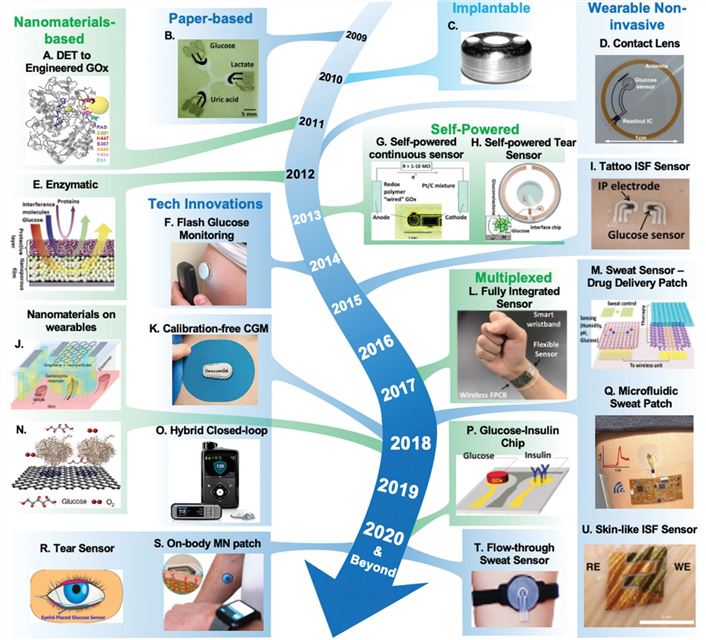Glucose detection is of great importance in a variety of fields ranging from biomedical applications to ecological approaches. Generally, there are five principal transducer classes, optical, electrochemical, thermometric, piezoelectric, and magnetic. The majority of the current glucose biosensors are of the electrochemical type due to their low cost, better sensitivity, reproducibility, and easy maintenance. Electrochemical glucose sensors could be further subdivided into potentiometric, amperometric, or conductometric types.
 Fig.1 A type of glucose electrochemical biosensor.1
Fig.1 A type of glucose electrochemical biosensor.1
Principles of Electrochemical Glucose Sensing
- Enzymatic glucose biosensors
- Non-enzymatic glucose biosensors
- Nanomaterials-based electrochemical glucose biosensors
The enzymatic and non-enzymatic sensing of glucose are two main categories of glucose sensing. Amperometric nonenzymatic glucose sensors based on the direct electrochemical oxidation of glucose have triggered great interest and have been widely exploited. The greatest advantage of amperometric nonenzymatic glucose sensing over enzymatic biosensing is that the former has addressed the problem of insufficient long-term stability, which is the most common and serious problem for enzymatic glucose sensors originating from the intrinsic nature of enzymes. Similar to other sensing platforms, glucose biosensors have been the target to incorporate nanomaterials such as metal nanoparticles (MNPs), nanotubes (NTs), and quantum dots (QDs).
Three Generations of Enzyme-based Amperometric Glucose Biosensors
The first-generation amperometric glucose biosensors take the physiological mediator O2 as the Medox to regenerate GOx(FAD) and detect glucose based on monitoring the consumption of O2 or the generation of H2O2 in the process of the enzymatic reaction. The catalytic process of second-generation amperometric glucose biosensors includes the following three steps: the transfer of electrons from glucose to the two FAD reaction centers of GOx, the transfer of electrons from the FADH2 centers to the artificial mediators, and the transport of electrons through the artificial mediators to the electrode. The third-generation amperometric glucose biosensors are fascinating because they function in the ideal biosensing model in the absence of mediators.
Construction of Electrochemical Cells for Amperometric Glucose Biosensors
The improvement of electrochemical detector cells is highly desirable because of their extensive use in many field. The effective immobilization of enzymes, the protection of the bioactivity of enzymes, and their integration and applications are the key factors for the fabrication of successful electrochemical cells.
- The immobilization of enzymes on sensing electrodes: physical adsorption, covalent attachment, entrapment or encapsulation
- The determination of enzymatic activity
- The integration of electrochemical cells for biosensors
Reference
- Juska, Vuslat B., and Martyn E. Pemble. "A critical review of electrochemical glucose sensing: Evolution of biosensor platforms based on advanced nanosystems." Sensors 20.21 (2020): 6013. Distributed under Open Access license CC BY 4.0, without modification.
For Research Use Only.

